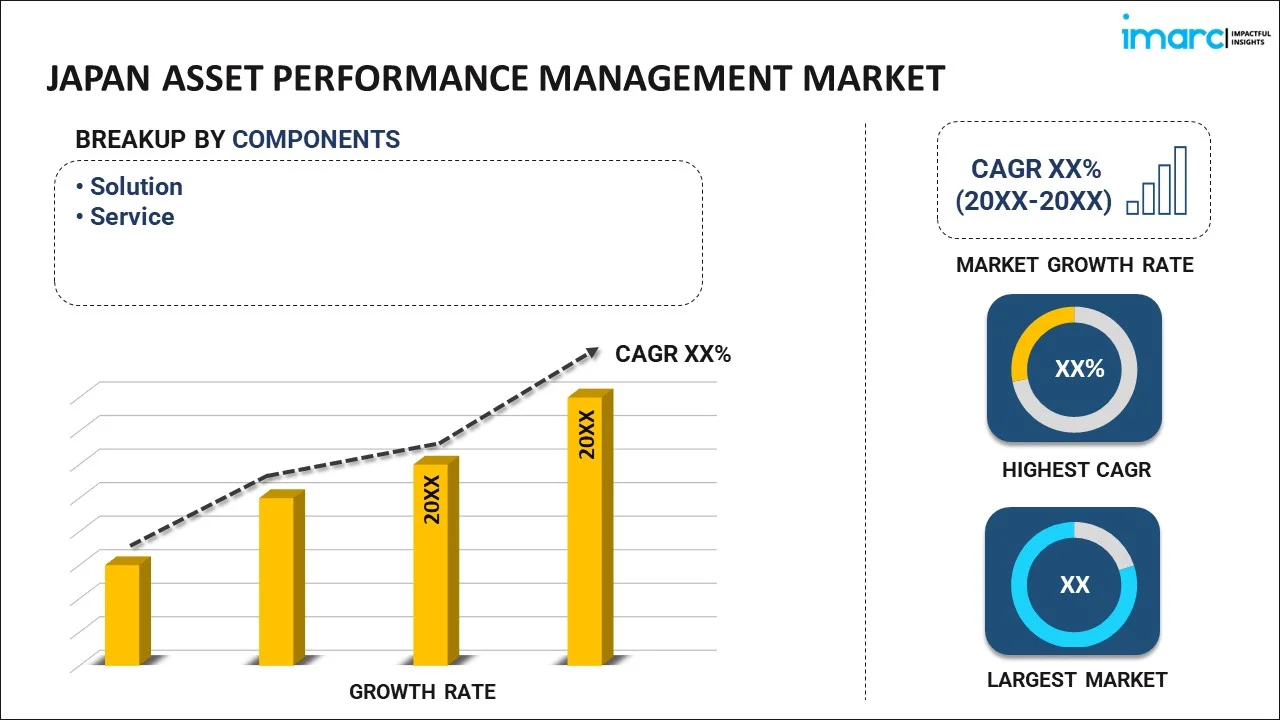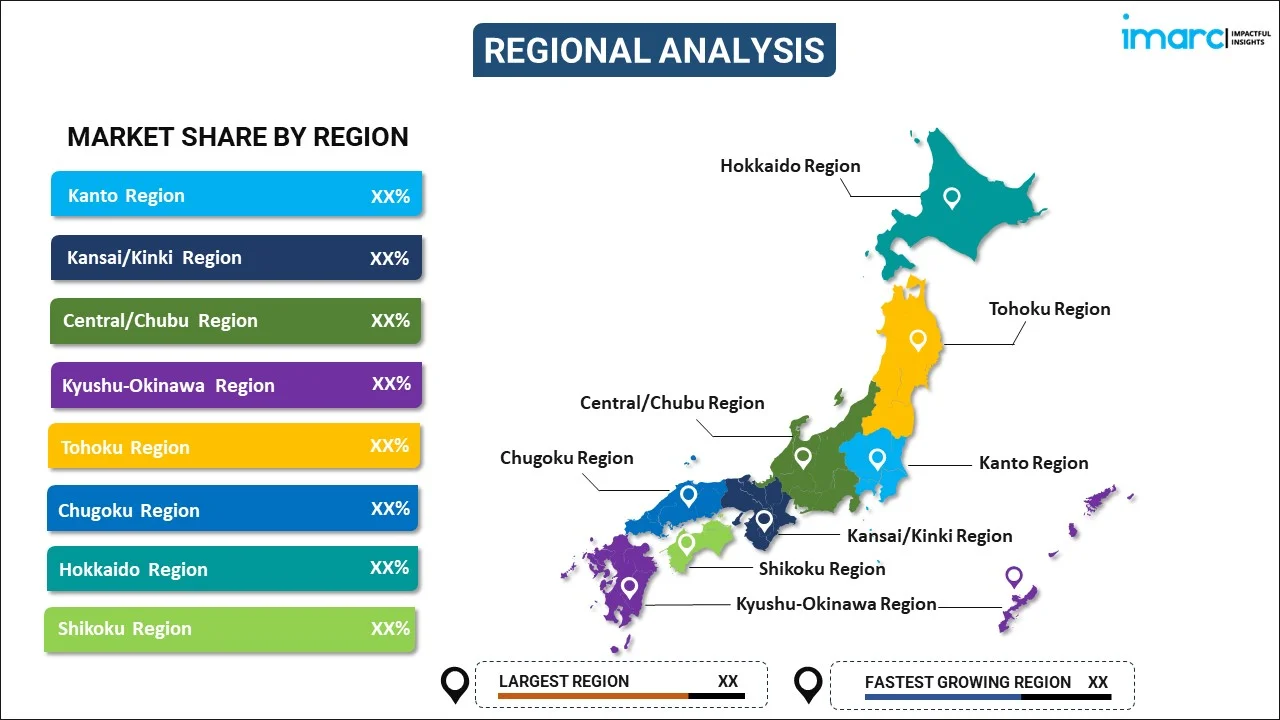
Japan Asset Performance Management Market Report by Component (Solution, Service), Deployment Mode (On-premises, Cloud-based), Organization Size (Large Enterprises, Small and Medium-sized Enterprises), Industry Vertical (Energy and Utilities, Oil and Gas, Manufacturing, Mining and Metals, Healthcare and Life Sciences, Chemical and Pharmaceuticals, Government and Defense, IT and Telecom, Food and Beverages, and Others), and Region 2026-2034
Market Overview:
Japan asset performance management market size reached USD 1,076.2 Million in 2025. Looking forward, IMARC Group expects the market to reach USD 3,515.9 Million by 2034, exhibiting a growth rate (CAGR) of 14.06% during 2026-2034. The rising need among businesses for empowering the workforce and improving the overall equipment effectiveness (OEE) is primarily driving the market growth.
|
Report Attribute
|
Key Statistics
|
|---|---|
|
Base Year
|
2025
|
|
Forecast Years
|
2026-2034
|
|
Historical Years
|
2020-2025
|
| Market Size in 2025 | USD 1,076.2 Million |
| Market Forecast in 2034 | USD 3,515.9 Million |
| Market Growth Rate 2026-2034 | 14.06% |
Asset performance management (APM) utilizes pattern recognition, artificial intelligence (AI), machine learning (ML), and the collection, integration, presentation, and analysis of data to enhance the dependability and accessibility of physical assets. Its role involves minimizing unexpected downtime, lowering maintenance expenses, and reducing the overall ownership costs of assets, plants, and environmental, health, and safety (EH&S) risks. Furthermore, it aims to optimize the performance of assets, boost the return on assets (ROA), and enhance operational transparency. Consequently, APM sees wide-ranging applications across multiple industries in Japan, including manufacturing, healthcare, information technology (IT), and telecommunications.
Japan Asset Performance Management Market Trends:
The asset performance management market in Japan stands as a thriving sector driven by the nation's commitment to technological innovation and industrial excellence. Several factors contribute to the growth and significance of the market in Japan. Firstly, Japan's manufacturing sector, renowned for its precision and quality, heavily relies on asset performance management solutions to optimize the performance and reliability of physical assets. With a strong focus on lean manufacturing and operational efficiency, Japanese industries actively adopt APM to minimize unplanned downtime and reduce maintenance costs, thereby bolstering productivity. Secondly, the healthcare sector in Japan recognizes the importance of asset performance management in ensuring the continuous operation of critical medical equipment and infrastructure. In a country with a rapidly aging population, the need for reliable and efficient asset management becomes paramount. Furthermore, Japan's robust information technology (IT) and telecommunications industries employ APM to maintain the resilience and availability of network infrastructure. Additionally, Japan's commitment to environmental, health, and safety (EH&S) standards aligns with APM's role in mitigating risks associated with asset failures and ensuring compliance. In conclusion, the Japan asset performance management market flourishes due to its application in diverse sectors, including manufacturing, healthcare, IT, and telecommunications. The country's dedication to quality, innovation, and operational excellence makes APM a pivotal component in maintaining and enhancing asset reliability and performance, which is expected to fuel the regional market in the coming years.
Japan Asset Performance Management Market Segmentation:
IMARC Group provides an analysis of the key trends in each segment of the market, along with forecasts at the country level for 2026-2034. Our report has categorized the market based on component, deployment mode, organization size, and industry vertical.
Component Insights:

- Solution
- Services
The report has provided a detailed breakup and analysis of the market based on the component. This includes solution and service.
Deployment Mode Insights:
- On-premises
- Cloud-based
A detailed breakup and analysis of the market based on the deployment mode have also been provided in the report. This includes on-premises and cloud-based.
Organization Size Insights:
- Large Enterprises
- Small and Medium-sized Enterprises
The report has provided a detailed breakup and analysis of the market based on the organization size. This includes large enterprises and small and medium-sized enterprises.
Industry Vertical Insights:
- Energy and Utilities
- Oil and Gas
- Manufacturing
- Mining and Metals
- Healthcare and Life Sciences
- Chemical and Pharmaceuticals
- Government and Defense
- IT and Telecom
- Food and Beverages
- Others
A detailed breakup and analysis of the market based on the industry vertical have also been provided in the report. This includes energy and utilities, oil and gas, manufacturing, mining and metals, healthcare and life sciences, chemical and pharmaceuticals, government and defense, IT and telecom, food and beverages, and others
Regional Insights:

- Kanto Region
- Kansai/Kinki Region
- Central/ Chubu Region
- Kyushu-Okinawa Region
- Tohoku Region
- Chugoku Region
- Hokkaido Region
- Shikoku Region
The report has also provided a comprehensive analysis of all the major regional markets, which include Kanto Region, Kansai/Kinki Region, Central/ Chubu Region, Kyushu-Okinawa Region, Tohoku Region, Chugoku Region, Hokkaido Region, and Shikoku Region.
Competitive Landscape:
The market research report has also provided a comprehensive analysis of the competitive landscape. Competitive analysis such as market structure, key player positioning, top winning strategies, competitive dashboard, and company evaluation quadrant has been covered in the report. Also, detailed profiles of all major companies have been provided.
Japan Asset Performance Management Market Report Coverage:
| Report Features | Details |
|---|---|
| Base Year of the Analysis | 2025 |
| Historical Period | 2020-2025 |
| Forecast Period | 2026-2034 |
| Units | Million USD |
| Scope of the Report | Exploration of Historical and Forecast Trends, Industry Catalysts and Challenges, Segment-Wise Historical and Predictive Market Assessment:
|
| Components Covered | Solution, Service |
| Deployment Modes Covered | On-premises, Cloud-based |
| Organization Sizes Covered | Large Enterprises, Small and Medium-sized Enterprises |
| Industry Verticals Covered | Energy and Utilities, Oil and Gas, Manufacturing, Mining and Metals, Healthcare and Life Sciences, Chemical and Pharmaceuticals, Government and Defense, IT and Telecom, Food and Beverages, Others |
| Regions Covered | Kanto Region, Kansai/Kinki Region, Central/ Chubu Region, Kyushu-Okinawa Region, Tohoku Region, Chugoku Region, Hokkaido Region, Shikoku Region |
| Customization Scope | 10% Free Customization |
| Post-Sale Analyst Support | 10-12 Weeks |
| Delivery Format | PDF and Excel through Email (We can also provide the editable version of the report in PPT/Word format on special request) |
Key Questions Answered in This Report:
- How has the Japan asset performance management market performed so far and how will it perform in the coming years?
- What has been the impact of COVID-19 on the Japan asset performance management market?
- What is the breakup of the Japan asset performance management market on the basis of component?
- What is the breakup of the Japan asset performance management market on the basis of deployment mode?
- What is the breakup of the Japan asset performance management market on the basis of organization size?
- What is the breakup of the Japan asset performance management market on the basis of industry vertical?
- What are the various stages in the value chain of the Japan asset performance management market?
- What are the key driving factors and challenges in the Japan asset performance management?
- What is the structure of the Japan asset performance management market and who are the key players?
- What is the degree of competition in the Japan asset performance management market?
Key Benefits for Stakeholders:
- IMARC’s industry report offers a comprehensive quantitative analysis of various market segments, historical and current market trends, market forecasts, and dynamics of the Japan asset performance management market from 2020-2034.
- The research report provides the latest information on the market drivers, challenges, and opportunities in the Japan asset performance management market.
- Porter's five forces analysis assist stakeholders in assessing the impact of new entrants, competitive rivalry, supplier power, buyer power, and the threat of substitution. It helps stakeholders to analyze the level of competition within the Japan asset performance management industry and its attractiveness.
- Competitive landscape allows stakeholders to understand their competitive environment and provides an insight into the current positions of key players in the market.
Need more help?
- Speak to our experienced analysts for insights on the current market scenarios.
- Include additional segments and countries to customize the report as per your requirement.
- Gain an unparalleled competitive advantage in your domain by understanding how to utilize the report and positively impacting your operations and revenue.
- For further assistance, please connect with our analysts.
 Request Customization
Request Customization
 Speak to an Analyst
Speak to an Analyst
 Request Brochure
Request Brochure
 Inquire Before Buying
Inquire Before Buying




.webp)




.webp)












